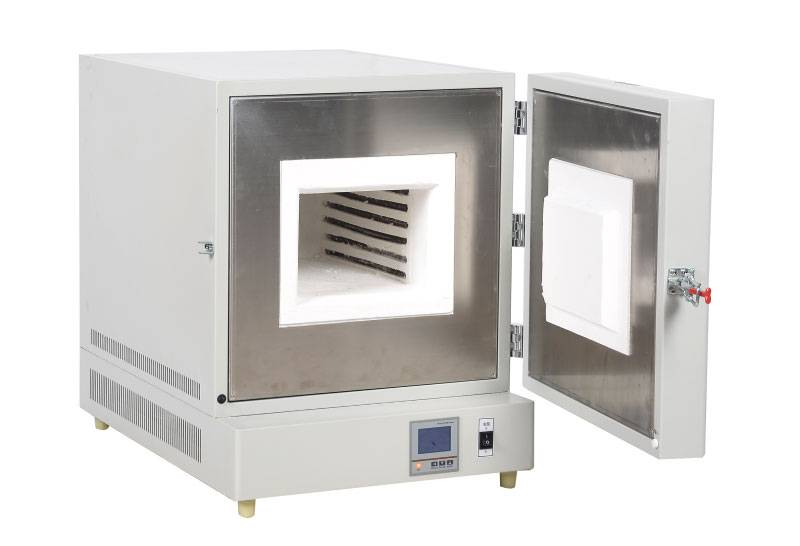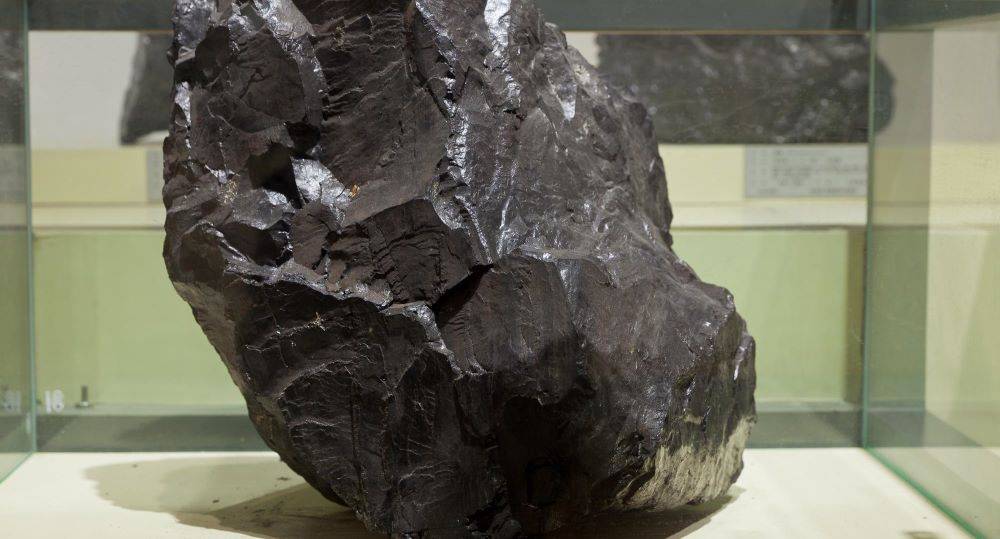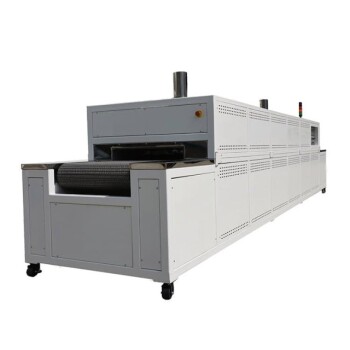مبادئ أفران الدثر وهيكلها
أنواع أفران الدثر
تأتي أفران الدثر في المختبرات بأشكال مختلفة، يتميز كل منها بمبادئ التسخين والتطبيقات الفريدة الخاصة بها. وتشمل الأنواع الأكثر شيوعًا الأفران الكهربائية وأفران المايكروويف وأفران الغاز، وكل منها يلبي احتياجات محددة داخل المجتمع العلمي.
وتحظى أفران الدثر الكهربائية بتقدير كبير لتعدد استخداماتها في مهام مثل التشكيل والصهر والتجفيف وتسخين المواد. على عكس أفران الحث، التي تعتمد على المجالات الكهرومغناطيسية لتسخين المواد، تستخدم أفران الدثر الكهربائية عناصر حرارية مسخنة كهربائيًا موضوعة داخل حاوية معدنية صلبة. يسمح لها هذا التصميم بالعمل في درجات حرارة أعلى وبكثافات طاقة أكبر، مما يجعلها مناسبة للتطبيقات الأكثر تطلبًا.
تمثل الأفران ذات درجة الحرارة المرتفعة من النوع الصندوقي نوعًا كلاسيكيًا من الأفران المطفأة، وغالبًا ما تشبه الصندوق في الشكل. توفر هذه الأفران عزلًا حراريًا محسّنًا وأبعادًا قابلة للتخصيص، وعادةً ما تتميز بتصميم مربع مع باب يفتح من الأمام. وغالبًا ما يتضمن تصميم الباب بابًا داخليًا لتحسين الحفاظ على الحرارة، مما يجعل الأفران الصندوقية خيارًا شائعًا في العديد من المختبرات.
أفران ثيرمولين ثيرمولين هي نوع آخر متخصص، وهي معروفة بشكل خاص بتطبيقاتها الصناعية على سطح الطاولة. يمكن أن تصل درجة حرارة هذه الأفران إلى 1200 درجة مئوية، مما يجعلها مثالية للعمليات ذات درجات الحرارة العالية في البيئات الصناعية.
من خلال فهم هذه الأنواع المختلفة من أفران الدثر، يمكن للباحثين والمختبرات اختيار المعدات الأكثر ملاءمة لتلبية احتياجاتهم الخاصة.

آليات التسخين
تستخدم أفران الدثر آليات تسخين مختلفة لتحويل الطاقة الكهربائية إلى طاقة حرارية. وتشمل الأنواع الأكثر شيوعًا الأفران الكهروحرارية وأفران الدثر التي تعمل بالموجات الدقيقة، ويستخدم كل منها طرقًا مختلفة لتوليد الحرارة.
أفران الدثر الكهربائية الحرارية
تولد أفران الدثر الكهربائية الحرارية الحرارة من خلال تسخين جول وهي عملية يمر فيها تيار كهربائي عبر موصل، مما يؤدي إلى تسخينه بسبب المقاومة. هذه الطريقة فعالة للغاية وتستخدم على نطاق واسع في الإعدادات المختبرية للتحكم الدقيق في درجة الحرارة. وعناصر التسخين، المصنوعة عادةً من مواد مثل النيتشروم أو الكانثال، مصممة لتحمل درجات الحرارة العالية، مما يضمن توليد حرارة ثابتة وموثوقة.
أفران المايكروويف الدافئة
على النقيض من ذلك، تستخدم أفران المايكروويف الدافئة الموجات الدقيقة لتحويل الطاقة الكهربائية إلى طاقة حرارية. وتنطوي هذه العملية على تفاعل الموجات الدقيقة مع المادة داخل الفرن، مما يتسبب في حدوث هياج جزيئي يؤدي إلى تسخين سريع وموحد. وتكمن ميزة هذه الطريقة في قدرتها على تسخين المواد بسرعة وبشكل موحد، مما يجعلها مناسبة بشكل خاص للتطبيقات التي تتطلب معالجة حرارية سريعة.
تقدم كلتا آليتي التسخين مزايا فريدة من نوعها، وتلبي الاحتياجات الصناعية والبحثية المختلفة. يعد فهم هذه المبادئ أمرًا بالغ الأهمية لاختيار فرن التسخين الأكثر ملاءمة لتطبيقات محددة.
المكونات الرئيسية
المكونات الرئيسية للأفران المكتومة جزء لا يتجزأ من وظائفها وكفاءتها. وتشمل هذه المكونات ما يلي:
-
عناصر التسخين: هذه العناصر ضرورية لتوليد الحرارة اللازمة داخل الفرن. يمكن أن تكون مصنوعة من مواد مختلفة مثل كربيد السيليكون أو السبائك المعدنية، وكل منها يقدم خصائص فريدة مثل المتانة ومقاومة الحرارة.
-
مواد العزل: العزل عالي الجودة ضروري للحفاظ على درجة الحرارة الداخلية ومنع فقدان الحرارة. وتشمل المواد الشائعة ألياف السيراميك والطوب الحراري، والتي توفر عزلًا حراريًا ممتازًا ودعمًا هيكليًا.
-
غرفة الفرن: هذه هي المنطقة الأساسية التي تتم فيها عملية التسخين الفعلية. وعادة ما تكون الحجرة مصنوعة من سبائك أو سيراميك عالي الحرارة لتحمل الظروف القاسية وضمان تسخين منتظم.
-
أنظمة التحكم في درجة الحرارة: أنظمة التحكم المتقدمة ضرورية لتنظيم درجة الحرارة بدقة. وغالبًا ما تتضمن هذه الأنظمة وحدات تحكم رقمية ومزدوجات حرارية ووحدات تحكم PID (تناسبية-إنترغرينال-مشتقة) للحفاظ على درجات حرارة ثابتة وأتمتة عملية التسخين.
ويؤدي كل من هذه المكونات دورًا متميزًا في ضمان عمل فرن الدثر بفعالية وكفاءة، مما يلبي احتياجات مجموعة واسعة من التطبيقات الصناعية والمعملية.
البحث والتطوير في أفران الدثر
التطور التاريخي
تميز تطور أفران الدثر بمعالم هامة، خاصة في فترة ما بعد الحرب العالمية الثانية. خلال هذه الفترة، أحدثت التطورات التكنولوجية ثورة في هذه الصناعة، مع التركيز بشكل خاص على التحكم في درجة الحرارة والأتمتة. وكانت هذه الابتكارات مدفوعة بالحاجة إلى عمليات تسخين أكثر دقة وكفاءة، والتي كانت ضرورية للقطاعات الصناعية والعلمية المزدهرة.
كان أحد الإنجازات الرئيسية هو تطوير أنظمة متقدمة للتحكم في درجة الحرارة. فقد سمحت هذه الأنظمة بتنظيم أكثر دقة لدرجات حرارة التدفئة، وهو أمر ضروري لضمان نتائج متسقة في مختلف التطبيقات. وبالإضافة إلى ذلك، أدى دمج تقنيات الأتمتة إلى تقليل الحاجة إلى التدخل اليدوي، وبالتالي زيادة الكفاءة وتقليل مخاطر الخطأ البشري.
وعلاوة على ذلك، شهدت فترة ما بعد الحرب طفرة في جهود البحث والتطوير التي تهدف إلى تحسين التصميم الهيكلي وكفاءة الطاقة في أفران التسخين. وأدى ذلك إلى إنشاء أفران أكثر قوة وتنوعًا يمكن تكييفها مع مجموعة واسعة من الاستخدامات الصناعية والعلمية. ولم تقتصر التطورات في هذه المجالات على تحسين أداء الأفران المكتومة فحسب، بل وسّعت أيضًا من تطبيقاتها في مختلف المجالات.
وباختصار، كانت حقبة ما بعد الحرب العالمية الثانية فترة محورية لتطوير أفران المفل، حيث تميزت بابتكارات تكنولوجية مهمة شكلت المشهد الحديث لتقنيات التسخين والمعالجة.
البحوث المحلية والدولية
ساهمت الأبحاث في الصين وخارجها بشكل كبير في التقدم في تكنولوجيا أفران الدثر. وقد ركزت هذه الجهود في المقام الأول على ثلاثة مجالات رئيسية: التصميم الهيكلي، وتوحيد درجة الحرارة، وكفاءة الطاقة.
من حيث التصميم الهيكلي أدخلت الأبحاث الدولية مواد وتصميمات مبتكرة تعزز متانة وأداء أفران الدثر. على سبيل المثال، أدى استخدام السيراميك المقاوم لدرجات الحرارة العالية ومواد العزل المتقدمة إلى تحسين السلامة الهيكلية العامة وطول عمر هذه الأفران.
توحيد درجة الحرارة كانت نقطة محورية أخرى في البحث، خاصةً في ضمان اتساق التسخين عبر غرفة الفرن بأكملها. وقد أدت الدراسات إلى تطوير أنظمة متطورة للتحكم في درجة الحرارة وتحسين عناصر التسخين التي توزع الحرارة بشكل متساوٍ. وقد كان هذا أمرًا بالغ الأهمية للتطبيقات التي تتطلب تنظيمًا دقيقًا لدرجة الحرارة، كما هو الحال في الكيمياء التحليلية وتخليق المواد.
كفاءة الطاقة أيضًا تحسينات كبيرة. فقد طور الباحثون آليات تسخين أكثر كفاءة وحسّنوا العزل الحراري لمكونات الأفران. على سبيل المثال، أدى تكامل التقنيات الموفرة للطاقة مثل المبادلات الحرارية المتجددة إلى تقليل استهلاك الطاقة بشكل كبير. ولا تؤدي هذه التطورات إلى خفض التكاليف التشغيلية فحسب، بل تساهم أيضًا في الاستدامة البيئية من خلال تقليل هدر الطاقة.
وعمومًا، مهدت الجهود التعاونية للباحثين المحليين والدوليين الطريق لأفران دثر أكثر تقدمًا وموثوقية وكفاءة، تلبي احتياجات مجموعة واسعة من التطبيقات الصناعية والعلمية.
الشركات البارزة
يهيمن العديد من اللاعبين الرئيسيين على سوق أفران الدثر، ويساهم كل منهم بشكل كبير في التقدم التكنولوجي ومعايير الجودة في هذه الصناعة. كاربوليت جيرو (المملكة المتحدة) التي تتميز بأفرانها الموفل عالية الأداء، والتي تشتهر بدقتها وموثوقيتها في مختلف البيئات المختبرية. وبالمثل نابرثرثرم (ألمانيا) نفسها كشركة رائدة، حيث تقدم مجموعة واسعة من أفران الدثر التي تلبي احتياجات التطبيقات الصناعية والبحثية على حد سواء.
في السوق الآسيوية حققت شركة Zhengzhou Coentec Instrument Co., Ltd. (الصين) خطوات كبيرة، لا سيما في تطوير حلول أفران دثر فعالة من حيث التكلفة وعالية الجودة في الوقت نفسه. لا تنتج هذه الشركات أحدث المعدات فحسب، بل تستثمر أيضًا بكثافة في البحث والتطوير، مما يضمن بقاء منتجاتها في طليعة الابتكار التكنولوجي.
| اسم الشركة | البلد | المساهمات الرئيسية |
|---|---|---|
| كاربوليت جيرو | المملكة المتحدة | أفران مفلطحة عالية الأداء والدقة |
| نابرثرثرم | ألمانيا | مجموعة واسعة من أفران الدثر للتطبيقات المتنوعة |
| أداة تشنغتشو كوينتيك | الصين | حلول أفران دثر فعالة من حيث التكلفة وعالية الجودة |
تواصل هذه الشركات البارزة تشكيل مستقبل تكنولوجيا أفران الدثر، مما يؤدي إلى تحسينات في الكفاءة والمتانة وسهولة الاستخدام.

تطبيقات أفران الدثر
الاستخدامات الصناعية
تلعب أفران الدثر دورًا حاسمًا في مختلف القطاعات الصناعية، لا سيما في المعالجة الحرارية ومعالجة قطع العمل وتركيب المواد. هذه الأفران لا غنى عنها في صناعات مثل الأسمنت ومواد البناء، حيث تسهل المعالجة الحرارية العالية للمواد الخام والمنتجات النهائية.
في صناعة الأسمنت، تُستخدم أفران الدثر لتكليس المواد الخام، وهي عملية تحول كربونات الكالسيوم الخام إلى جير، وهو مكون رئيسي في إنتاج الأسمنت. وتعد خطوة المعالجة الحرارية هذه ضرورية لضمان جودة واتساق منتج الأسمنت النهائي. وبالمثل، في قطاع مواد البناء، تُستخدم هذه الأفران في المعالجة الحرارية للسيراميك والطوب ومواد البناء الأخرى، مما يعزز متانتها وسلامتها الهيكلية.
وعلاوة على ذلك، تعتبر الأفران المكتومة حيوية في تركيب المواد المتقدمة، مثل السيراميك والمواد المركبة، والتي تتطلب تحكمًا دقيقًا في درجة الحرارة وتسخينًا موحدًا. إن قدرة هذه الأفران على الحفاظ على درجات حرارة عالية مع عزل عملية التسخين عن البيئة تجعلها مثالية لهذه التطبيقات، مما يضمن خضوع المواد للتغيرات الكيميائية والفيزيائية اللازمة دون تلوث.
وباختصار، تعد أفران الدثر جزءًا لا يتجزأ من العمليات الصناعية في الأسمنت ومواد البناء، مما يساهم بشكل كبير في جودة وكفاءة المعالجات الحرارية وتركيب المواد.
الكيمياء الطبية والتحليلية
تلعب أفران الدثر دورًا محوريًا في مجال الكيمياء الطبية والتحليلية، حيث تخدم العديد من التطبيقات الهامة. هذه الأفران لا غنى عنها في عمليات فحص الأدوية، حيث تسهل عملية التسخين والمعالجة الدقيقة للعينات الصيدلانية لضمان نقاوتها وفعاليتها. وبالإضافة إلى ذلك، تُستخدم أفران الدثر في المعالجة المسبقة للعينات، وهي خطوة حاسمة في إعداد العينات للإجراءات التحليلية اللاحقة، وبالتالي تعزيز دقة النتائج وموثوقيتها.
في التحليل البيئي، تُستخدم أفران الدثر لتحليل عينات المياه والهواء، مما يساعد في الكشف عن الملوثات والملوثات. وهذا التطبيق حيوي للحفاظ على الصحة البيئية وضمان الامتثال للمعايير التنظيمية. وعلاوة على ذلك، تُعد هذه الأفران ضرورية في تحليل جودة الزيوت، حيث تساعد في تحديد تركيبة الزيوت وخصائصها، وهو أمر بالغ الأهمية لصناعات مثل البترول والسيارات.
إن تعدد استخدامات ودقة أفران الدثر تجعلها أداة لا تقدر بثمن في هذه التطبيقات الكيميائية التحليلية والطبية، مما يساهم بشكل كبير في التقدم في هذه المجالات.
تحليل الفحم
يعد تحليل الفحم عملية حاسمة في تقييم جودة الفحم وملاءمته لمختلف التطبيقات الصناعية. يركز هذا التحليل في المقام الأول على تحديد المعلمات الرئيسية مثل الرطوبة والرماد والمواد المتطايرة والتركيب العنصري. وتوفر كل من هذه المعلمات رؤى قيمة حول سلوك الفحم في ظل ظروف مختلفة وفائدته العامة في العمليات الصناعية.
-
محتوى الرطوبة: هذا هو مقياس للماء الموجود في الفحم، والذي يمكن أن يؤثر بشكل كبير على قيمة التسخين وخصائص المناولة. يمكن أن يؤدي ارتفاع محتوى الرطوبة إلى عدم كفاءة الاحتراق والنقل.
-
محتوى الرماد: الرماد هو البقايا غير القابلة للاحتراق المتبقية بعد احتراق الفحم. يمكن أن يقلل المحتوى العالي من الرماد من الكفاءة الحرارية للفحم ويزيد من تكلفة التخلص من الرماد.
-
المادة المتطايرة: تشير إلى الغازات القابلة للاحتراق المنبعثة أثناء تسخين الفحم. يؤثر محتوى المادة المتطايرة على خصائص اشتعال الفحم وحرقه، مما يؤثر على كفاءة الاحتراق والانبعاثات البيئية.
-
تحليل العناصر: يتضمن تحديد تركيزات العناصر مثل الكربون والهيدروجين والنيتروجين والكبريت والأكسجين في الفحم. وتلعب هذه العناصر دوراً حاسماً في فهم التركيب الكيميائي للفحم وتأثيره البيئي.

يعد استخدام أفران الدثر في تحليل الفحم أمرًا بالغ الأهمية نظرًا للتحكم الدقيق في درجة الحرارة وقدرات التسخين المنتظمة. وتتيح هذه الأفران الحصول على نتائج دقيقة وقابلة للتكرار، وهو أمر ضروري للصناعات التي تعتمد على الفحم كمصدر أساسي للطاقة.
الآفاق المستقبلية
التخصيص والابتكار
من المتوقع أن يتسم مستقبل تكنولوجيا الأفران المطفأة بتحول عميق نحو حلول مخصصة وذكية وموفرة للطاقة وذات كفاءة في استخدام الطاقة . هذه التطورات ليست مجرد تطورات تدريجية ولكنها تمثل نقلة نوعية في كيفية تصميم أفران الدثر واستخدامها في مختلف الصناعات.
الحلول المخصصة
سيكون التخصيص محركًا رئيسيًا، مما يسمح بتصميم أفران كاتم الصوت وفقًا للمتطلبات الفريدة للقطاعات المختلفة. على سبيل المثال، في المجال الطبي، قد يتم تحسين الأفران للتحكم الدقيق في درجة الحرارة والحد الأدنى من التلوث، وهو أمر ضروري لفحص الأدوية والمعالجة المسبقة للعينات. وفي المقابل، قد تتطلب التطبيقات الصناعية تصميمات قوية قادرة على التعامل مع الإنتاجية العالية والظروف القاسية.
الأتمتة الذكية
سيشكل الذكاء في الأفران المكتومة اتجاهاً مهماً آخر، حيث سيستفيد من الأتمتة المتقدمة وتقنيات الذكاء الاصطناعي. ستوفر هذه الأنظمة الذكية ميزات مثل الصيانة التنبؤية والمراقبة في الوقت الحقيقي وآليات التحكم التكيفية. على سبيل المثال، يمكن أن يقوم فرن الدثر الذي يعمل بالذكاء الاصطناعي بضبط ملف التسخين بشكل مستقل بناءً على المواد التي تتم معالجتها، مما يضمن تحقيق أفضل النتائج وتقليل هدر الطاقة.
كفاءة الطاقة
تظل كفاءة الطاقة محور تركيز بالغ الأهمية، لا سيما في ضوء المخاوف البيئية المتزايدة والضغوط التنظيمية. سوف تشتمل أفران الدثر المستقبلية على مواد عزل وعناصر تسخين متطورة، مما يقلل من استهلاك الطاقة دون المساس بالأداء. وستعمل الابتكارات في الإدارة الحرارية وأنظمة استعادة الحرارة المهدرة على تعزيز ملاءمتها للبيئة.
باختصار، من المقرر أن يتسم مستقبل الأفران المطفأة بمزيج من التخصيص والذكاء وكفاءة الطاقة، مما يلبي الاحتياجات المتنوعة والمتطورة للصناعات في جميع أنحاء العالم.
تعزيز تجربة المستخدم
يتضمن تعزيز تجربة المستخدم في تقنية الأفران المكتومة نهجًا متعدد الأوجه يعطي الأولوية للسلامة والكفاءة التشغيلية والتكامل السلس مع الأدوات التحليلية. وقد صُممت هذه التحسينات ليس فقط لتحسين الأداء ولكن أيضًا لجعل المعدات أكثر سهولة في الاستخدام وقابلة للتكيف مع الاحتياجات الصناعية المختلفة.
تحسينات السلامة
تظل السلامة هي الشغل الشاغل في البيئات المختبرية والصناعية. تم تجهيز الأفران المكتومة الحديثة بآليات سلامة متقدمة، بما في ذلك ميزات الإغلاق الآلي، ومراقبة درجة الحرارة في الوقت الحقيقي، ومواد العزل القوية التي تقلل من مخاطر الحوادث الحرارية. تضمن هذه الميزات أنه يمكن للمستخدمين تشغيل الأفران بثقة، مع العلم أن سلامتهم تحظى بالأولوية.
الكفاءة التشغيلية
تركز تحسينات الكفاءة على تقليل استهلاك الطاقة وزيادة سرعة ودقة عمليات التسخين. وتساهم الابتكارات مثل أنظمة التحكم الذكية في درجة الحرارة وعناصر التسخين الموفرة للطاقة في دورات تسخين أسرع وتنظيم أكثر دقة لدرجة الحرارة. وهذا لا يوفر الوقت فحسب، بل يقلل أيضًا من تكاليف التشغيل، مما يجعل أفران التسخين المطفأة أكثر اقتصادًا في الاستخدام.
انتظام التسخين
يعد تحقيق تسخين موحد عبر حجرة الفرن أمرًا بالغ الأهمية لتحقيق نتائج متسقة في معالجة المواد وتحليلها. تشتمل التصميمات الجديدة على أنظمة توزيع حراري متقدمة تضمن توزيع الحرارة بشكل متساوٍ، مما يزيل البقع الساخنة والباردة. هذا التوحيد ضروري لمهام مثل التلدين والتلبيد والتفاعلات الكيميائية، حيث يكون التحكم الدقيق في درجة الحرارة ضروريًا.
التكامل مع الأدوات التحليلية
يعزز تكامل الأفران المكتومة مع الأدوات التحليلية من فائدتها في البحث العلمي والتطبيقات الصناعية. على سبيل المثال، يتيح الربط مع أجهزة قياس الطيف والكروماتوغرافيا والأدوات التحليلية الأخرى جمع البيانات وتحليلها في الوقت الفعلي. يعمل هذا التكامل على تبسيط سير العمل، مما يوفر للباحثين والفنيين مجموعات بيانات شاملة يمكن تحليلها على الفور، وبالتالي تسريع وتيرة التجارب والابتكار.
من خلال التركيز على هذه المجالات الرئيسية، يتم تحسين تجربة المستخدم مع أفران الدثر بشكل كبير، مما يجعلها أدوات أكثر تنوعًا وموثوقية وكفاءة في مختلف الصناعات.
المنتجات ذات الصلة
- فرن البوتقة بدرجة حرارة 1200 درجة مئوية للمختبر
- فرن بوتقة 1700 درجة مئوية للمختبر
- فرن الفرن الكتم 1400 درجة مئوية للمختبر
- فرن بوتقة 1800 درجة مئوية للمختبر
- فرن جو متحكم فيه بدرجة حرارة 1200 درجة مئوية فرن جو خامل بالنيتروجين















